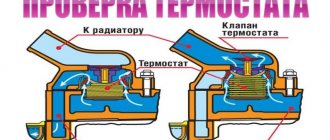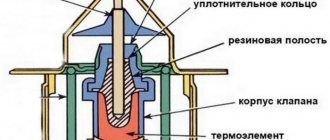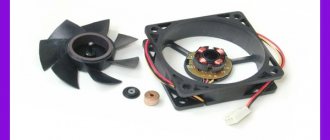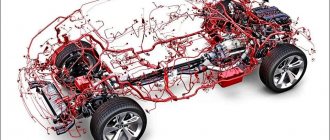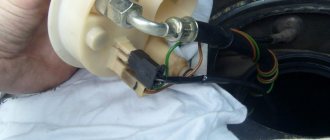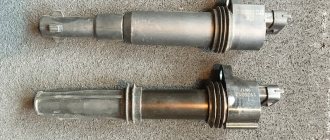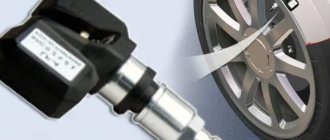The thermostat is a key component of the cooling system, which is responsible for high-quality engine warm-up by timely redirecting coolant flows in a small or large circle.
Failure of this unit inevitably leads to a number of problems - overheating of the power unit or the inability of it to reach the desired temperature.
That's why a car enthusiast needs to know how to check the thermostat and what malfunctions of this device exist.
Common Causes of Thermostat Problems
During the operation of the car, the following thermostat breakdowns and the reasons for their occurrence are possible.
- INCREASED HEATING TIME OF THE POWER UNIT. The engine operates unstably (for example, troits), which leads to excessive vibrations of the device valve and damage to its seat. Due to exposure to strong vibration, damage to the temperature-sensitive element occurs. The result is that coolant gets inside the unit (wax comes out), which leads to a malfunction of the device, which stops opening or closing the valve when the required temperature level is reached.
- THE OPENING OCCURS EARLIER OF TIME. The cause of such a breakdown may be the ingress of coolant into a special element that controls the temperature level of antifreeze in the system. The result is an increase in the total volume of filler and premature opening.
- THE THERMOSTAT OPENING IS DELAYED. The reason is the appearance of a leak of a special filler that allows the device to respond to temperature changes. Changing the volume of this element downward will require more heating to open. The result is that the thermostat operates with a certain time delay.
- THE ENGINE OVERHEATS REGULARLY. For example, there may be situations where the thermostat allows coolant to pass through on time, but the engine still overheats. The reason is that the fluid is not passing through the main radiator, but is being discharged through the return line back into the engine.
- THERMOSTAT IS NOT COMPLETELY OPEN. The reason is mechanical damage. The result is a small volume of liquid entering the radiator, and, as a result, overheating of the power unit.
- NOT COMPLETELY CLOSED. This is possible when coolant “sneaks” into the working element. Due to the increase in the volume of the working element, the valve disc cannot close completely.
- INCORRECT OPERATION OF THE DEVICE. For example, opening and closing it ahead of time. This is possible in case of failures in the factory settings and excessive overheating of the cooling system of the power unit.
- DESTRUCTION OF RUBBER SEALING. Due to a breakdown, oil gets into the coolant. The latter acts as a solvent for the rubber seal (rubber simply cannot withstand aggressive influences).
Cleaning
Often the cause of thermostat failure is scale, which clogs the cavities of valves and springs. The result of this is a “freeze” of the valve, which leads to the fact that the power unit cannot reach the optimal temperature regime without heating up enough or, conversely, overheating. It is best to replace such a “stuck” thermostat.
Resuscitation of the device is available to almost every car enthusiast. Any product for kettles or water heating equipment is suitable for cleaning. The technology itself boils down to boiling a thermostat in such a solution for 20 minutes.
After this procedure, you should flush the entire cooling system using special products.
Ways to solve problems
Possible solutions to the problem include:
1. If the coolant temperature exceeds the norm (provided the thermostat is working and it is correctly selected), it is necessary to replace the device, but with a higher opening temperature. As a rule, this step is recommended for motorists who operate cars in the mountains and in regions with hot climates.
2. When opening the thermostat late, it is important to ensure that there are no plugs and that the system is completely filled. If the problem is caused by a plug (coolant stagnation), then the best solution is to make a small hole in the plate (2-3 mm). As a result, the coolant flow around the thermostat is normalized, and the engine warm-up time increases.
3. Early opening of the thermostat is possible due to excessive pressure in the system. Zones of different pressure often appear around the device, which leads to its early operation. There are several reasons:
- failure of the cooling system;
- The thermostat spring has weakened;
- The engine runs at higher speeds during the warm-up period.
4. The engine takes too long to warm up.
Causes:
- incomplete closing of the thermostat;
- violation of the integrity of the valve plate (for example, a gap has appeared);
- Incorrect position (possibly changing the location of the air valve).
5. The engine heats up above normal even in a situation where the thermostat is fully open:
- traffic jams or low coolant level;
- failure of the radiator (clogging of its cells);
- failure of the cooling pump or fan;
- contamination of the cooling system.
What will you need for replacement?
Before starting work, you need to make sure you have:
- New working part.
- Wrenches or socket heads with a ratchet and an extension “10” and “13”.
- Phillips and slotted screwdrivers (depending on the bolt heads of the worm clamps used).
- Containers with a volume of about 10 liters for coolant, preferably low and wide; a basin is perfect for this role. If you plan to reuse antifreeze, the container must be clean.
In most cases, up to three new clamps and at least 1–2 liters of antifreeze, similar to that poured into the car, will also be useful, because it is difficult to completely eliminate coolant loss when draining it. The following will help increase the convenience and efficiency of repairs:
- Socket wrench “7” or “8”, suitable for loosening and tightening clamps.
- Pliers that make it easier to remove the factory-installed band clamps on the Classic.
- A funnel for collecting coolant, for example, cut from a plastic bottle.
Often, replacing the thermostat on a Zhiguli is combined with pouring fresh antifreeze and installing new pipes or other parts of the cooling system. In this case, it is necessary to purchase the appropriate spare parts and coolant (total filling volume is 8.65 liters, that is, a little more than 9.5 kg).
Checking the Thermostat
The problems described above can appear at any time. To avoid engine overheating and damage, you need to know how to check the thermostat directly on the car and after dismantling it at home.
It is important to know that after starting the engine, the thermostat is still closed and the coolant flows through a small circuit (through the cooling jacket and the stove). This allows the power unit to quickly reach the desired temperature.
As soon as the required level is reached, the valve opens and coolant flows through the main radiator.
Understanding this principle is very important when checking the thermostat.
Therefore, we invite you to familiarize yourself with the diagram.
Let's consider two diagnostic options.
Without dismantling
The easiest way is not to remove the unit, but to check it directly on the car. The main condition is a cold engine.
The diagnostic process begins with starting the power unit and warming it up for 2-3 minutes at idle.
This time is not enough for the engine to warm up and the coolant to circulate in a large circle, so the radiator is not yet connected to the general cooling system.
To check that the system is working correctly, touch the pipe that goes to the top of the main radiator with your hand.
The pipe should be cold, which signals the passage of coolant in a small circle (only through the engine and stove).
Therefore, the valve of the device under test is in the closed position (as it should be at this stage).
Continue to monitor engine cooling system performance. As soon as the coolant warms up to 90 degrees Celsius (can be controlled by the sensor), touch the inlet pipe. The thermostat should be open at this moment.
In this case, the coolant is directed in a maximum circle (encompassing the radiator). In such a situation, the pipe that extends from the radiator will be well heated.
By the way, the lower pipe of the cooling system, extending from the radiator, will also be hot.
If the condition described above is not met, then we can talk about a breakdown of the thermostat and its incorrect operation (for example, the valve could be jammed). In such a situation, you need to check it and replace it if necessary.
The second option is also possible, when after starting the engine the tube leading to the radiator warms up almost immediately.
One of the reasons is the valve jamming in the open position and, as a result, the coolant moving in a large circle at once.
The result in this case is obvious - the power unit will not operate in normal mode due to the impossibility of reaching normal temperature conditions.
Such a malfunction is not dangerous for the engine, but can lead to increased fuel consumption.
Situations are possible when the valve “hangs” in the middle position, that is, it does not close or open fully. The problem is diagnosed by the long warm-up of the power unit.
It is more difficult to determine a malfunction in “field” conditions.
In this case, checking the thermostat can only be done by dismantling it.
Checking the functionality of the thermostat by removing
If it is not possible to determine the breakdown without dismantling, then proceed as follows:
- pour the antifreeze into a container prepared in advance. In this case, first install the vessel, and then unscrew the drain plug. To speed up the process of coolant release, unscrew the cap on the expansion tank;
- If there is no such plug, then place a container under the lower part of the radiator pipe. loosen the clamp that holds the pipe to the radiator and remove the pipe itself. Wait until the coolant is completely drained into the container, and then proceed to dismantle the thermostat;
- dismantle the outlet pipe;
- take the thermostat and go to the kitchen. There you will need a stove, a saucepan (or any other metal container) and water. Pour in the liquid and set the pan to heat. Then place the assembly in water so that the body part does not touch the walls of the container itself;
- install a special thermometer in the water and monitor changes in its readings, as well as the actions of the valve itself;
- as soon as the desired temperature is reached, the unit should operate and open. This is possible thanks to the precise operation of the device’s working substance (artificial wax). When heated, the wax expands and allows the valve to operate. If it still does not work at the required temperature, then we can draw conclusions about the unsuitability of the entire assembly (we will talk about the operation temperature below);
- remove the thermostat from the water and let it cool. If the node worked earlier, it should close after a while. Again, if this does not happen, then it needs to be changed.
Features of testing on VAZ series cars
VAZ cars continue to be a truly “people's” vehicle. Let's look at how to check the thermostat on a car of this brand.
To begin with, we note that on all models of the Volzhsky Automobile Plant (VAZ 2107, 2114, 2109, 2110, 2114 and others), the principle of checking the thermostat is identical. The only thing that can change is the opening and closing temperature. But this information can be found in the instructions for your car.
As in previous cases, verification is carried out using two methods.
Important points
When replacing a thermostat, there are a couple of important nuances that cannot be ignored. Here they are:
- on the latest models of “sevens” (cars 2010 and older), the clamps on the thermostat are not worm-type, but band-type. This means that you won’t be able to remove them with a regular flat-head screwdriver, and to remove them you will have to use a special clamp wrench, which not every car owner has in their garage. If the car owner is the “happy” owner of a thermostat with band clamps, then there is only one way out: go to the store for a tool. A clamp wrench costs about 300 rubles;
So, changing the thermostat on the “seven” is not a difficult task. Preparatory procedures take much more time: cooling the engine and completely draining the antifreeze from the system. Nevertheless, even a novice car owner can cope with these procedures. The main thing is to take your time and strictly follow the recommendations given above.
How to check a thermostat when purchasing
When purchasing a new thermostat, blow into the fitting. This will ensure that the fitting is closed as tightly as possible when cooled.
Although this does not guarantee 100% quality, it will at least partially protect you from defects. Unfortunately, there are many defective thermostats on the market now.
Knowing how to check a thermostat, you can always identify a malfunction and avoid damage to the power unit.
Please remember that ignoring failures of this device can lead to engine overheating and failure. The result is even greater costs.
